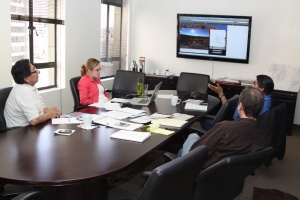CyArk holds Workshop for Tutuveni Digital Preservation Project
June 23, 2011
This spring, CyArk hosted an in house workshop for the Digital Preservation Project at Tutuveni, a Hopi petroglyph site in Arizona. The project was made possible through the generous support of the World Monuments Fund. WMF had included Tutuveni on its 2008 Watch List because of the threats, including vandalism, facing the site. As mentioned in previous blogs posted following the completion of field documentation at Tutuveni, CyArk is working with a great group of partners on this project. Project partners include the World Monuments Fund, University of Redlands, National Park Service Historic American Landscape Survey, the Hopi Cultural Preservation Office, the Navajo Nation Historic Preservation Department.
In attendance at the workshop were Associate Professor Wes Bernadini, from the University of Redlands, Lee Wayne Lomayestewa of the Hopi Cultural Preservation Office, and Patrick Secakuku, who attended the workshop as a Hopi educational consultant from the Hopi Junior/Senior High School. The goals of the workshop were to collaborate with the group on the design of the Tutuveni project page, history, and multimedia to be launched on the CyArk website as well as to create some exciting educational material for grade school age children using the content created for the project.
The workshop began with a presentation of the multimedia and draft project page CyArk has created for the Tutuveni Digital Preservation Project. The group was very engaged in the project and offered valuable feedback. Efforts were focused on how best to convey the story of Tutuveni and applicable Hopi history, as well as how to engage visitors to the virtual site in a way that fosters understanding and site stewardship. The group designed history slides for the project introduction slide show, reviewed and edited the textual information on the site, and gave feedback on the multimedia and conservation deliverables, based on the foreseen academic use and use by the Hopi Cultural Preservation Office. The workshop also included the drafting of a script for a project introduction video in English and Hopi.
The remainder of the workshop included the design and creation of three lesson plans and on-line educational activities to be used in Hopi schools, Arizona public schools, and available for broader use on the CyArk website. The lesson plans are designed to teach children ranging from elementary school through high school about the history of Tutuveni, the Hopi clan symbols found in the petroglyphs there, and the importance of protecting such sites and respecting our collective human history.
The workshop was a great success and I would like to give a special thanks to Wes Bernadini, Lee Wayne Lomayestewa, and Patrick Secakuku for their hard work and valuable contributions to the project. The CyArk team is very excited about the project and truly feels that Tutuveni is a very special site and will be a wonderful addition to the CyArk archive.
Stay tuned for more updates on the project, including the project’s public release.
In attendance at the workshop were Associate Professor Wes Bernadini, from the University of Redlands, Lee Wayne Lomayestewa of the Hopi Cultural Preservation Office, and Patrick Secakuku, who attended the workshop as a Hopi educational consultant from the Hopi Junior/Senior High School. The goals of the workshop were to collaborate with the group on the design of the Tutuveni project page, history, and multimedia to be launched on the CyArk website as well as to create some exciting educational material for grade school age children using the content created for the project.
The workshop began with a presentation of the multimedia and draft project page CyArk has created for the Tutuveni Digital Preservation Project. The group was very engaged in the project and offered valuable feedback. Efforts were focused on how best to convey the story of Tutuveni and applicable Hopi history, as well as how to engage visitors to the virtual site in a way that fosters understanding and site stewardship. The group designed history slides for the project introduction slide show, reviewed and edited the textual information on the site, and gave feedback on the multimedia and conservation deliverables, based on the foreseen academic use and use by the Hopi Cultural Preservation Office. The workshop also included the drafting of a script for a project introduction video in English and Hopi.
The remainder of the workshop included the design and creation of three lesson plans and on-line educational activities to be used in Hopi schools, Arizona public schools, and available for broader use on the CyArk website. The lesson plans are designed to teach children ranging from elementary school through high school about the history of Tutuveni, the Hopi clan symbols found in the petroglyphs there, and the importance of protecting such sites and respecting our collective human history.
The workshop was a great success and I would like to give a special thanks to Wes Bernadini, Lee Wayne Lomayestewa, and Patrick Secakuku for their hard work and valuable contributions to the project. The CyArk team is very excited about the project and truly feels that Tutuveni is a very special site and will be a wonderful addition to the CyArk archive.
Stay tuned for more updates on the project, including the project’s public release.

Group photo from the workshop. From left to right: Kristina Sturm, Scott Lee, Lee Wayne Lomayestewa, Wesley Bernadini, Patrick Secakuku, Landon Silla, Taline Ayanyan, and Myasha Nicholas

Workshop attendees and Kristina Sturm having a brainstorming meeting during the workshop.

Kristina Sturm and Patrick Secakuku work together on the lesson plans developed during the workshop.